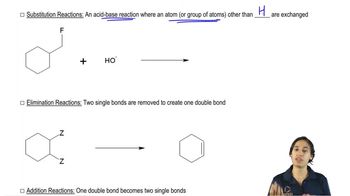Here are the essential concepts you must grasp in order to answer the question correctly.
Nucleophiles and Electrophiles
Nucleophiles are species that donate an electron pair to form a chemical bond, while electrophiles are electron-deficient species that accept an electron pair. In this reaction, dimethyl sulfide acts as a nucleophile, attacking the electrophilic chlorine molecule (Cl₂) to facilitate the substitution reaction that converts the alcohol to a chloroalkane.
Recommended video:
Nucleophile or Electrophile
Arrow-Pushing Mechanism
The arrow-pushing mechanism is a way to illustrate the movement of electrons during a chemical reaction. It shows how nucleophiles attack electrophiles and how bonds are formed or broken. In this case, arrows will depict the transfer of electrons from the nucleophile (dimethyl sulfide) to the electrophile (chlorine), leading to the formation of the chloroalkane.
Recommended video:
Substitution Reactions
Substitution reactions involve the replacement of one functional group in a molecule with another. In this scenario, the hydroxyl group (-OH) of the alcohol is replaced by a chlorine atom, resulting in the formation of a chloroalkane. Understanding the mechanism of substitution is crucial for predicting the products of reactions involving haloalkanes.
Recommended video:
Recognizing Substitution Reactions.







